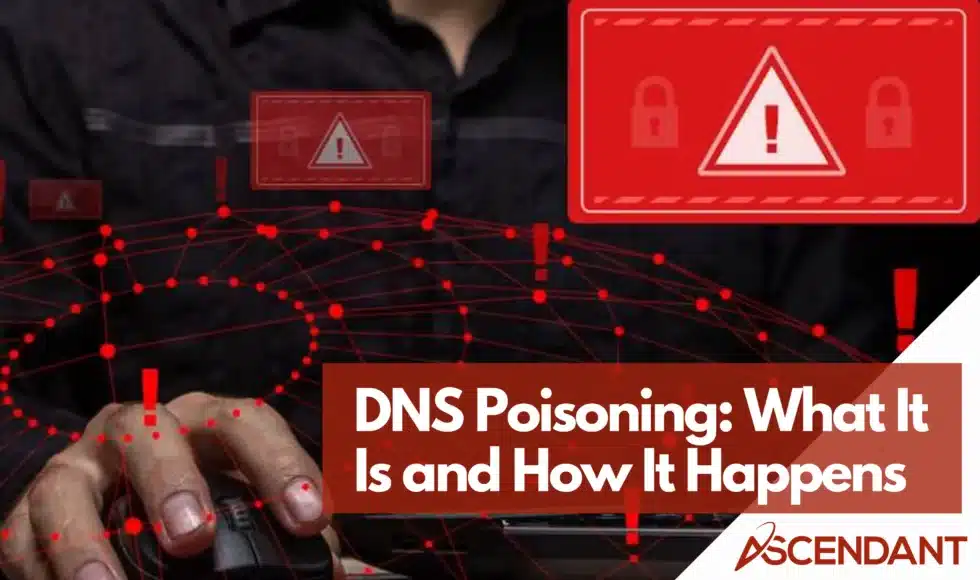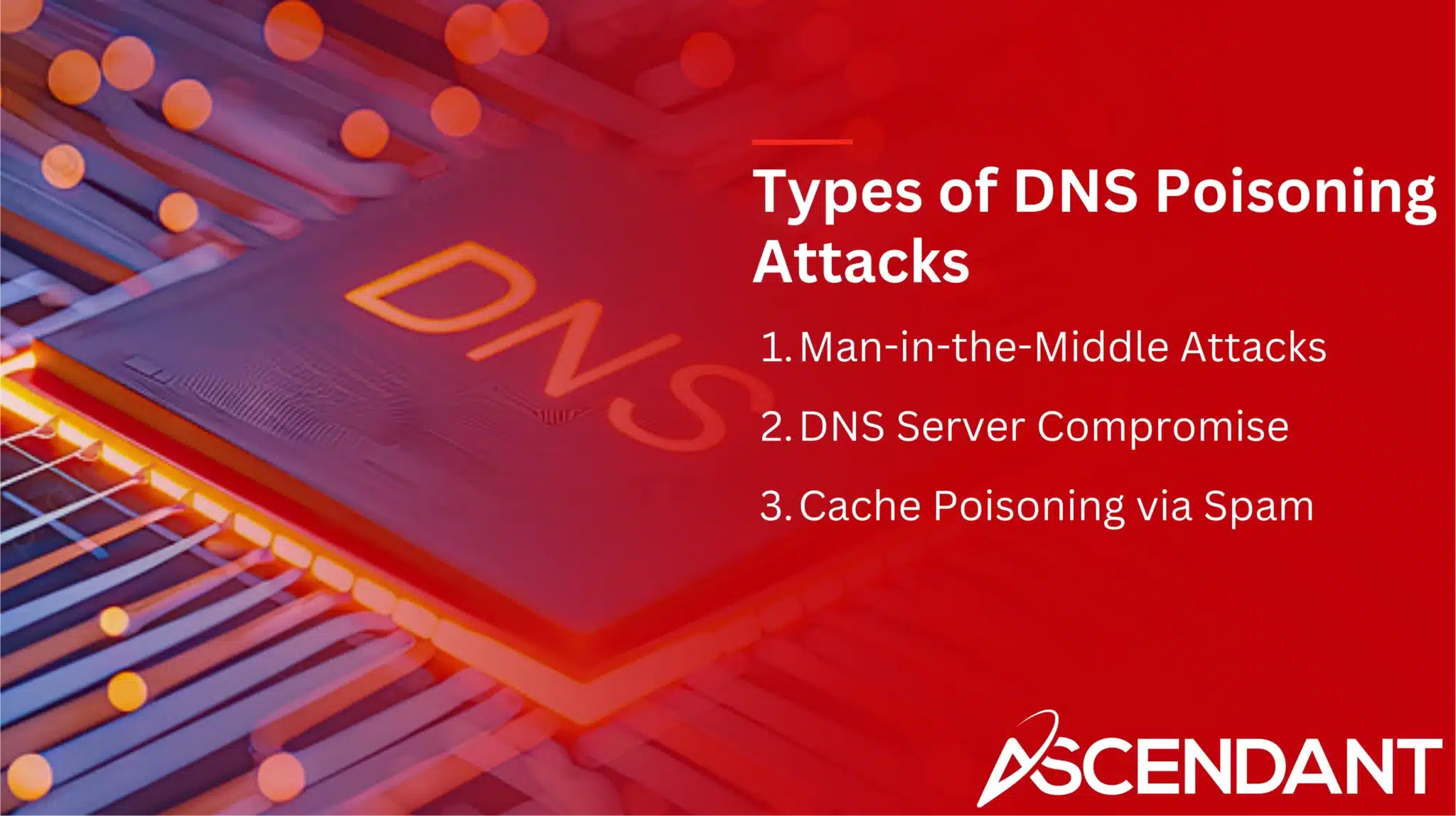DNS poisoning is a cyber-attack where false DNS responses redirect users to malicious sites. This threat can result in data theft, malware distribution, and misinformation. In this article, we’ll explain how DNS poisoning works, its various forms, and strategies to prevent it.
In This Article:
- Understanding DNS Poisoning
- Types of DNS Poisoning Attacks
- Consequences of DNS Poisoning
- Detection and Remediation of DNS Poisoning
- Preventing DNS Poisoning
- Enhancing Network Security
Key Takeaways
- DNS poisoning is a serious internet threat that redirects users to harmful sites by manipulating DNS records.
- Prevention strategies include implementing DNSSEC, using source port randomization, and regular system updates to close vulnerabilities.
- Detection of DNS poisoning can be facilitated through signs of unusual redirects, SSL certificate mismatches, and unexpected DNS record changes.
Understanding DNS Poisoning
DNS cache poisoning, commonly referred to as DNS spoofing, poses a considerable risk to both individuals and organizations using the internet. This nefarious act is carried out by providing fake responses to DNS requests, which then corrupts the domain resolution process, causing users to be redirected to malicious websites. A thorough comprehension of how DNS operates is crucial for recognizing the severity of such attacks and highlights the necessity for implementing protective measures.
When attackers alter DNS records through cache poisoning tactics, they can deceive users into visiting imposter sites crafted with intentions like pilfering sensitive information or disseminating malware. Such actions not only jeopardize user data, but also significantly erode confidence in the security and reliability of online communications. Addressing this threat effectively hinges on an informed awareness about how DNS functions and its associated security gaps.
How DNS Works
The Domain Name System (DNS) functions as the internet’s directory, converting user-friendly domain names into IP addresses that computers use to locate each other on a network. As you type a domain name in your browser, it initiates a DNS query. This prompts your device to communicate with a DNS resolver. The resolver then searches its cache for an already resolved IP address corresponding to the requested domain name and, if unavailable, escalates the query through various levels of servers such as root, TLD, and authoritative servers until it acquires the correct IP.
To optimize efficiency by minimizing redundant queries, both clients and servers involved in DNS operations store previously determined answers within their local cache system. Unfortunately, cybercriminals can exploit these cached entries via techniques leading to what is known as cache poisoning or DNS spoofing.
These caches essentially act as record books maintaining lists of domains paired with their associated IPs and detailed records ensuring quicker subsequent lookups—a process pivotal for smooth web navigation yet equally critical from a security standpoint due to vulnerabilities like potential tampering incidents.
The Mechanics of DNS Poisoning
DNS cache poisoning, also known as DNS spoofing, is an attack where adversaries select a specific domain they wish to compromise. They craft numerous counterfeit responses to impersonate the authoritative server for that domain by exploiting weaknesses such as predictable source ports and limited transaction IDs. The false response must precisely match the original query’s transaction ID and source port for the dns spoofing assault to be effective. After successfully injecting falsified data into the DNS records associating the target domain with a malicious IP address, any user trying to access that particular website is misdirected towards potentially harmful sites due to this nefarious manipulation.
The circulation of these tainted DNS entries can result in wide-ranging consequences across various systems and services within our digital infrastructure due to their interconnected nature. To exacerbate matters, Attackers might alter Time-To-Live (TTL) values associated with DNS records—thus extending how long incorrect information remains stored in caches—and ensuring continued impact from their intrusion.
Assailants may deploy tactics like distributing malware through spam emails as another avenue for initiating attacks on a system’s DNS cache, aiming at embedding corrupt information without raising suspicion among users or administrators until it has managed its intended effect on targeted domains or servers.
Types of DNS Poisoning Attacks
Various forms of DNS poisoning attacks, each utilizing distinct tactics and having different consequences, must be identified to create robust defense mechanisms. These attack types range from Man-in-the-Middle schemes to breaches involving the DNS server itself and cache poisoning that leverages spam – all targeting particular weaknesses within the DNS framework.
Man-in-the-Middle Attacks
DNS poisoning involving a man-in-the-middle attack happens when an attacker manages to insert themselves into the conversation between a user’s web browser and their DNS server. This intercept enables them to modify the cache data, which can then be used to mislead users by sending them off course to harmful IP addresses that facilitate activities such as data theft or malware dissemination.
Leveraging known weaknesses in how communication is handled during this process renders these types of attacks particularly menacing due to their ability effectively exploit vulnerabilities for nefarious purposes.
DNS Server Compromise
In a DNS server compromise, attackers gain control over DNS servers and configure them to return malicious IP addresses. Hijacking DNS servers enables attackers to manipulate responses, directing users to fraudulent websites designed to steal data or distribute malware.
This manipulation of DNS records to insert false data into caches is a hallmark of DNS cache poisoning.
Cache Poisoning via Spam
Emails containing spam may serve as a conduit for DNS cache poisoning, incorporating harmful scripts that tamper with the DNS cache. These emails, when engaged with by users, can trigger the execution of such code and result in corrupting the resolver’s cache with fraudulent DNS data.
By exploiting how users typically behave, this technique is employed to commence attacks on DNS caching systems. It represents an extensive risk due to its reliance on user interaction to facilitate cache poisoning assaults.
Consequences of DNS Poisoning
DNS poisoning can lead to a wide array of serious outcomes that affect both individual users and entire organizations. These repercussions encompass:
- The theft of sensitive data
- Distribution of malicious software
- Enforced censorship
- Spread of misinformation
By exploiting weaknesses in the DNS protocol, cyber attackers are able to reroute user traffic toward dangerous websites through DNS poisoning.
Data Theft
DNS poisoning attacks are a serious security risk as they divert users to harmful sites that can lead to the compromise of sensitive data. In the instance of MyEtherWallet being targeted, unsuspecting individuals were routed to an imitation site through DNS redirection, culminating in their login information being stolen.
Users may inadvertently provide personal details on a mimicked website without realizing it, rendering data theft a typical fallout from such DNS poisoning onslaughts.
Malware Distribution
Attackers can exploit a DNS server through DNS poisoning, altering the DNS records to redirect users toward nefarious websites with the intent of spreading malware. By tampering with the server’s responses, they orchestrate redirects that expose users to sites laden with harmful software, thus elevating the probability of malware attacks.
Censorship and Misinformation
By exploiting DNS poisoning, attackers can obstruct the path to legitimate websites and disseminate false information. This tactic of spoofing critical sites has the potential to redirect users away from vital updates on security, thereby exposing their systems to attacks. The repercussions of such censorship and the spreading of misinformation are significant for both individual internet users and organizations at large.
Detection and Remediation of DNS Poisoning
Maintaining the integrity of DNS infrastructure necessitates the detection and remediation of DNS poisoning attacks. Employing security protocols alongside tools designed for detecting DNS spoofing is essential in identifying and combating these threats, requiring constant vigilance.
Signs of DNS Poisoning
Unusual website redirects to unexpected or malicious sites can signal a DNS cache poisoning attack. SSL/TLS certificate mismatches may indicate that the user is being redirected to a fraudulent site.
Additionally, unexpected changes in DNS records are significant indicators of a poisoning attack.
Steps to Remediate DNS Poisoning
If DNS servers are suspected of being compromised, isolate or disconnect them immediately. Flushing the DNS cache removes false information and ensures correct site data is used.
Restore DNS records to their correct values and patch vulnerable systems or software to prevent future attacks.
Preventing DNS Poisoning
To safeguard the DNS infrastructure from poisoning, it is critical to adopt best security measures and practices. Strengthening DNS security can be significantly achieved through implementing redundancy mechanisms, incorporating regular updates, and enabling robust security features.
Implement DNSSEC
Domain Name System Security Extensions (DNSSEC) verify the authenticity of DNS data using public-key cryptography. DNSSEC enhances the DNS ecosystem’s security by validating DNS responses and preventing attackers from injecting false information.
Use Source Port Randomization
Randomizing the source port for DNS queries enhances security by decreasing predictability, thus complicating attempts at executing DNS poisoning attacks. This technique of source port randomization adds complexity to an attacker’s challenge in forecasting query patterns.
Regular System Updates
It is essential to regularly update the DNS server software on your system, as this process applies the latest security patches and closes any vulnerabilities that could otherwise be leveraged in DNS poisoning attacks. Maintaining up-to-date software shields against exploiting known weaknesses.
Enhancing Network Security
Enhancing network security involves continuous monitoring and implementing measures to protect against DNS spoofing attacks, including regular updates and deploying security tools like WAF, IDS, and IPS.
Intrusion Detection Systems (IDS)
Enhancing threat detection capabilities, Intrusion Detection Systems (IDS) provide real-time monitoring and notifications for unusual DNS traffic. By examining the content of packets on a protected network, a network-based IDS identifies dubious activities through continuous surveillance of all traffic.
Response Rate Limiting (RRL)
Response Rate Limiting (RRL) hampers DNS amplification attacks and decelerates attempts at cache poisoning by restricting the rate of responses to distinct client IP addresses, thus impeding the swift dissemination of erroneous DNS data.
Network Segmentation
Network segmentation involves dividing a network into segments to improve security. Isolating critical DNS infrastructure from other network parts controls access and reduces the risk of widespread compromise from a single breach.
Summary
In essence, the peril of DNS poisoning should not be underestimated due to its potential for enabling data theft, spreading malicious software, and propagating falsehoods. It is essential to grasp how DNS operates and the intricacies involved in DNS poisoning in order to set up formidable defense mechanisms. Organizations can shield their DNS frameworks from such incursions by embracing protective measures like employing Domain Name System Security Extensions (DNSSEC), randomizing source ports during queries, and maintaining regular updates of their systems.
To secure the integrity of the DNS landscape requires relentless attention as well as instituting stringent security protocols. Amplifying network defenses with instruments like Intrusion Detection Systems (IDS) and Response Rate Limiting (RRL), coupled with adopting strategies like network segmentation, can profoundly mitigate threats associated with DNS poisoning. Persistently advancing your security tactics is key in defending your online infrastructure against these risks.
 Frequently Asked Questions
Frequently Asked Questions
What is DNS poisoning?
DNS poisoning is a malicious attack that involves manipulating DNS records to misdirect users to harmful websites. This compromises the integrity of the DNS system and poses significant security risks.
How can I detect DNS poisoning?
You can detect DNS poisoning by observing unusual website redirects, SSL/TLS certificate mismatches, and unexpected changes in DNS records.
These signs indicate potential tampering with the DNS resolution process.
What is DNSSEC and how does it help?
DNSSEC enhances internet security by employing public-key cryptography to verify the authenticity of DNS data, thereby preventing attackers from injecting false information.
This ensures users can trust the integrity of the websites they visit.
Why is source port randomization important?
By randomizing the source port, predictability for potential attackers is significantly reduced, making it more difficult for them to carry out DNS poisoning attacks and thus bolstering the security of network communications.
What are some practical steps to remediate a DNS poisoning attack?
To effectively remediate a DNS poisoning attack, isolate the compromised DNS servers, flush the DNS cache, revert DNS records to their correct values, and ensure that all vulnerable systems and software are properly patched.
These steps are essential to restoring integrity and security to your DNS infrastructure.


